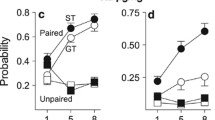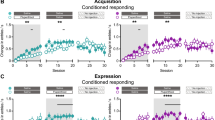Abstract
In the conditioned reinforcement paradigm, animals learn a new instrumental response reinforced solely by conditioned reward (a stimulus that has previously been associated with primary reward). It has been shown that psychostimulants potentiate responding for conditioned reward and there is evidence that the nucleus accumbens is involved in this effect. The present experiments extend this work and examine the roles of various striatal subregions in the enhancement of responding for conditioned reward. In the conditioning phase, hungry rats were trained to associate a light/click stimulus with food delivery, with no levers present in the operant chamber. In the test phase, two levers were present and responding on one provided conditioned reward (presentation of the compound stimulus but no food). During this phase, microinjections ofd-amphetamine (0, 0.2, 2.0, 20.0 µg/0.5 µl) were made into seven striatal subregions in separate groups of rats. Injection of amphetamine into the nucleus accumbens elicited a dose-dependent, selective increase in responding for CR. Injections into posterior regions of the striatum had no effect. Significant and selective increases in CR responding were noted after injections into two regions neighboring the nucleus accumbens, the anterior dorsal and the ventromedial striatum, although the magnitude of these effects was considerably less than that following accumbens injections. Injections into ventrolateral regions increased responding in some rats, but this effect was very variable and not selective for the CR lever. These results are interpreted as evidence for functional heterogeneity of the striatum with regard to enhancement of conditioned reinforcement. The findings are discussed in relation to the theory that increased dopaminergic activity in the nucleus accumbens results in amplification of the response to a previously learned reward-related signal.
Similar content being viewed by others
References
Beninger RJ (1983) The role of dopamine in locomotor activity and learning. Brain Res Rev 6:173–196
Beninger RJ, Phillips AG (1980) The effect of pimozide on the establishment of conditioned reinforcement. Psychopharmacology 68:147–153
Beninger RJ, Hahn BL (1983) Pimozide blocks establishment but not expression of amphetamine-produced environment-specific conditioning. Science 220:1304–1306
Beninger RJ, Hanson DR, Phillips AG (1980a) The effects of pipradrol on the aquisition of responding with conditioned reinforcement: a role for sensory preconditioning. Psychopharmacology 69:235–242
Beninger RJ, Mason ST, Phillips AG, Fibiger HC (1980b) The use of extinction to investigate the nature of neuroleptic-induced avoidance deficits. Psychopharmacology 69:11–18
Beninger RJ, Hanson DR, Phillips AG (1981) The acquisition of responding with conditioned reinforcement: effects of cocaine, (+)-amphetamine and pipradrol. Br J Pharmacol 74:149–154
Beninger RJ, Hoffman DC, Mazurski EJ (1989) Receptor subtype-specific dopaminergic agents and conditioned behavior. Neurosci Biobehav Rev 13:113–122
Blackburn JR, Phillips AG, Jakubovic A, Fibiger HC (1989) Dopamine and preparatory behavior: II. A neurochemical analysis. Behav Neurosci 103:15–23
Bruning JL, Kintz BL (1977) Computational handbook of statistics. Scott, Foresman, Glenview, Illinois
Cador M, Robbins TW, Everitt BJ (1989) Involvement of the amygdala in stimulus-reward associations: interaction with the ventral striatum. Neuroscience 30:77–87
Cador M, Taylor JR, Robbins TW (1990) Potentiation of the effects of reward-related stimuli by dopaminergic-dependent mechanisms in the nucleus accumbens. Psychopharmacology (in press)
Carr GD, White NM (1983) Conditioned place preference from intra-accumbens but not intra-caudate amphetamine injections. Life Sci 33:2551–2557
Carr GD, White NM (1986) Anatomical disassociation of amphetamine's rewarding and aversive effects: an intracranial microinjection study. Psychopharmacology 89:340–346
Di Chiara G, Imperato A (1988) Drugs abused by humans preferentially increase synaptic dopamine concentrations in the mesolimbic system of freely moving rats. Proc Natl Acad Sci USA 85:5274–5276
Fibiger HC, Phillips AG (1986) Reward, motivation, cognition: psychobiology of mesotelencephalic dopamine system. In: Mountcastle VB, Bloom FE, Geiger SR (eds) Handbook of physiology: the nervous system (vol 4). American Physiological Society, Bethesda, Maryland, pp 647–675
Gold LH, Swerdlow NR, Koob GF (1988) The role of mesolimbic dopamine in conditioned locomotion produced by amphetamine. Behav Neurosci 102:544–552
Hernandez L, Hoebel BG (1988) Food reward and cocaine increase extracellular dopamine in the nucleus accumbens as measured by microdialysis. Life Sci 42:1705–1712
Hill RT (1970) Facilitation of conditioned reinforcement as a mechanism of psychomotor stimulation. In: Costa E, Garattini S (eds) Amphetamine and related compounds. Raven Press, New York, pp 781–795
Hoebel BG, Monaco AP, Hernandez L, Aulissi E, Stanley BG, Lenard L (1983) Self-injection of amphetamine directly into the brain. Psychopharmacology 81:158–163
Jackson PM, Anden N-E, Dahlstrom A (1975) A functional effect of dopamine in the nucleus accumbens and in some other dopamine-rich parts of the rat brain. Psychopharmacology 45:139–149
Kelley AE, Delfs JM (1990) Dopamine and conditioned reinforcement. II. Contrasting effects of amphetamine microinjection into the nucleus accumbens with peptide microinjection into the ventral tegmental area. Psychopharmacology
Kelley AE, Domesick VB (1982) The distribution of the projection from the hippocampal formation to the nucleus accumbens in the rat: an anterograde- and retrograde-horseradish peroxidase study. Neuroscience 7:2321–2335
Kelley AE, Stinus L (1984) The distribution of the projection from the parataenial nucleus of the thalamus to the nucleus accumbens in the rat: an autoradiographic study. Exp Brain Res 54:499–512
Kelley AE, Domesick VB, Nauta WJH (1982) The amygdalostriatal projection in the rat — an anatomical study by anterograde and retrograde tracing methods. Neuroscience 7:615–630
Kelley AE, Lang CG, Gauthier AM (1988) Induction of oral stereotypy following amphetamine microinjection into a discrete sub-region of the striatum. Psychopharmacology 95:556–559
Kelly PH, Iversen SD (1976) Selective 6-OHDA induced destruction of mesolimbic dopamine neurons: abolition of psychostimulant-induced locomotor activity in rats. Eur J Pharmacol 40:45–56
Koob GF, Bloom FE (1988) Cellular and molecular mechanisms of drug dependence. Science 242:715–723
Kuczenski R, Segal D (1989) Concomitant characterization of behavioral and striatal neurotransmitter response to amphetamine using in vivo microdialysis. J Neurosci 9:2051–2065
Lyness WH, Friedle NM, Moore KE (1979) Destruction of dopaminergic nerve terminals in nucleus accumbens: effects ofd-amphetamine self-stimulation. Pharmacol Biochem Behav 11:553–556
Mackintosh NJ (1974) The psychology of animal learning. Academic Press, London
Mazurski EJ, Beninger RJ (1986) The effects of (+)-amphetamine and apomorphine on responding for a conditioned reinforcer. Psychopharmacology 90:239–243
McGeorge AJ, Faull RLM (1989) The organization of the projection from the cerebral cortex to the striatum in the rat. Neuroscience 29:503–537
Mogenson GJ, Jones DL, Yim CY (1980) From motivation to action: functional interface between the limbic system and the motor system. Prog Neurobiol 14:69–97
Neill DB, Herndon JG (1978) Anatomical specificity within rat striatum for the dopaminergic modulation of DRL responding and activity. Brain Res 153:529–538
Pellegrino LJ, Cushman AJ (1967) A stereotaxic atlas of the rat brain. Century Crofts, New York
Prado-Alcala R, Wise RA (1984) Brain stimulation reward and dopamine terminal fields. I. Caudate-putamen, nucleus accumbens and amygdala. Brain Res 297:265–273
Robbins TW (1975) The potentiation of conditioned reinforcement by psychomotor stimulant drugs. A test of Hill's hypothesis. Psychopharmacologia 45:103–114
Robbins TW (1976) Relationship between reward-enhancing and stereotypical effects of psychomotor stimulant drugs. Nature 264:57–59
Robbins TW (1978) The acquisition of responding with conditioned reinforcement: effects of pipradrol, methylphenidate,d-amphetamine, and nomifensine. Psychopharmacology 58:79–87
Robbins TW, Everitt BJ (1982) Functional studies of the central catecholamines. Int Rev Neurobiol 23:305–365
Robbins TW, Koob GF (1978) Pipradrol enhances reinforcing properties of stimuli paired with brain stimulation. Pharmacol Biochem Behav 8:219–222
Robbins TW, Watson BA, Gaskin M, Ennis C (1983) Contrasting interactions of pipradrol,d-amphetamine, cocaine, cocaine analogues, apomorphine and other drugs with conditioned reinforcement. Psychopharmacology 80:113–119
Sharp T, Zetterström T, Ljungberg T, Ungerstedt U (1987) A direct comparison of amphetamine-induced behaviours and regional brain dopamine release in the rat using intracerebral dialysis. Brain Res 401:322–330
Taylor JR, Robbins TW (1984) Enhanced behavioural control by conditioned reinforcers following microinjections ofd-amphetamine into the nucleus accumbens. Psychopharmacology 84:405–412
Taylor JR, Robbins TW (1986) 6-Hydroxydopamine lesions of the nucleus accumbens, but not of the caudate nucleus, attenuate enhanced responding with reward-related stimuli produced by intra-accumbensd-amphetamine. Psychopharmacology 90:390–397
Author information
Authors and Affiliations
Rights and permissions
About this article
Cite this article
Kelley, A.E., Delfs, J.M. Dopamine and conditioned reinforcement. Psychopharmacology 103, 187–196 (1991). https://doi.org/10.1007/BF02244202
Received:
Revised:
Issue Date:
DOI: https://doi.org/10.1007/BF02244202




